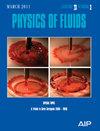A novel phase-field lattice Boltzmann framework for diffusion-driven multiphase evaporation
IF 4.1
2区 工程技术
Q1 MECHANICS
引用次数: 0
Abstract
Heat transfer and phase change phenomena, particularly diffusion-driven droplet evaporation, play pivotal roles in various industrial applications and natural processes. Despite advancements in computational fluid dynamics, modeling multiphase flows with large density ratios remains challenging. In this study, we developed a robust and stable conservative Allen–Cahn-based phase-field lattice Boltzmann method to solve the flow field equations. This method is coupled with the finite difference discretization of vapor species transport equation and the energy equation. The coupling between the vapor concentration and temperature field at the interface is modeled by the well-known Clausius–Clapeyron correlation. Our approach is capable of simulations under real physical conditions and is compatible with graphics processing unit architecture, making it ideal for large-scale industrial simulations. Three validation test cases are conducted to demonstrate the consistency of the presented model, including simulations of Stefan flow, the evaporation of suspended droplets containing water, acetone, and ethanol in the air, and the evaporation of a water sessile droplet on a flat surface. The results show that the model is able to predict the behavior and characteristics of each case accurately. Notably, our numerical results exhibit a maximum relative error of approximately 1% in simulations of Stefan flow. In the case of suspended droplet evaporation, the observed maximum difference between the calculated wet bulb temperatures and those derived from psychrometric charts is approximately 0.9 K. Moreover, our analysis of the sessile droplet reveals a good agreement between the results obtained by our model for the evaporative mass flux and those obtained from the existing models in the literature for different contact angles.扩散驱动多相蒸发的新型相场晶格玻尔兹曼框架
传热和相变现象,尤其是扩散驱动的液滴蒸发,在各种工业应用和自然过程中发挥着举足轻重的作用。尽管计算流体动力学取得了进步,但对大密度比的多相流建模仍具有挑战性。在本研究中,我们开发了一种基于 Allen-Cahn 的稳健、稳定的保守相场晶格玻尔兹曼方法来求解流场方程。该方法与蒸汽物种传输方程和能量方程的有限差分离散化相结合。界面上蒸汽浓度和温度场之间的耦合由著名的克劳修斯-克拉皮隆相关性建模。我们的方法能够在真实物理条件下进行模拟,并与图形处理器架构兼容,因此非常适合大规模工业模拟。为了证明所提出模型的一致性,我们进行了三个验证测试案例,包括模拟斯特凡流,空气中含有水、丙酮和乙醇的悬浮液滴的蒸发,以及平面上无柄水滴的蒸发。结果表明,模型能够准确预测每种情况的行为和特征。值得注意的是,在模拟斯特凡流时,我们的数值结果显示最大相对误差约为 1%。此外,我们对无柄水滴的分析表明,在不同接触角下,我们的模型获得的蒸发质量通量结果与文献中现有模型获得的结果非常一致。
本文章由计算机程序翻译,如有差异,请以英文原文为准。
求助全文
约1分钟内获得全文
求助全文
来源期刊

Physics of Fluids
物理-力学
CiteScore
6.50
自引率
41.30%
发文量
2063
审稿时长
2.6 months
期刊介绍:
Physics of Fluids (PoF) is a preeminent journal devoted to publishing original theoretical, computational, and experimental contributions to the understanding of the dynamics of gases, liquids, and complex or multiphase fluids. Topics published in PoF are diverse and reflect the most important subjects in fluid dynamics, including, but not limited to:
-Acoustics
-Aerospace and aeronautical flow
-Astrophysical flow
-Biofluid mechanics
-Cavitation and cavitating flows
-Combustion flows
-Complex fluids
-Compressible flow
-Computational fluid dynamics
-Contact lines
-Continuum mechanics
-Convection
-Cryogenic flow
-Droplets
-Electrical and magnetic effects in fluid flow
-Foam, bubble, and film mechanics
-Flow control
-Flow instability and transition
-Flow orientation and anisotropy
-Flows with other transport phenomena
-Flows with complex boundary conditions
-Flow visualization
-Fluid mechanics
-Fluid physical properties
-Fluid–structure interactions
-Free surface flows
-Geophysical flow
-Interfacial flow
-Knudsen flow
-Laminar flow
-Liquid crystals
-Mathematics of fluids
-Micro- and nanofluid mechanics
-Mixing
-Molecular theory
-Nanofluidics
-Particulate, multiphase, and granular flow
-Processing flows
-Relativistic fluid mechanics
-Rotating flows
-Shock wave phenomena
-Soft matter
-Stratified flows
-Supercritical fluids
-Superfluidity
-Thermodynamics of flow systems
-Transonic flow
-Turbulent flow
-Viscous and non-Newtonian flow
-Viscoelasticity
-Vortex dynamics
-Waves
 求助内容:
求助内容: 应助结果提醒方式:
应助结果提醒方式:


